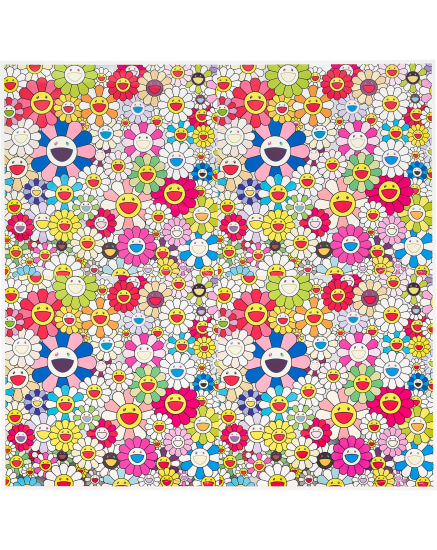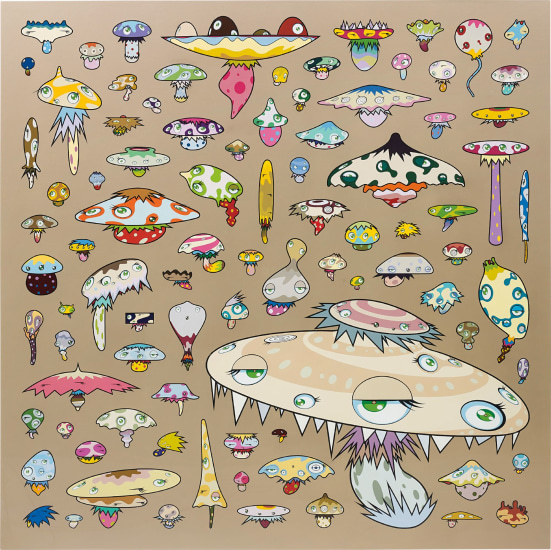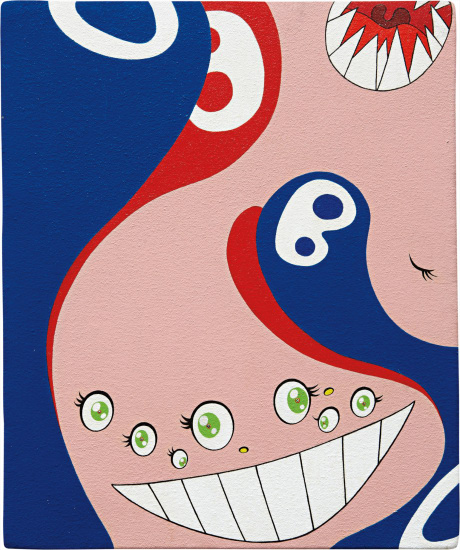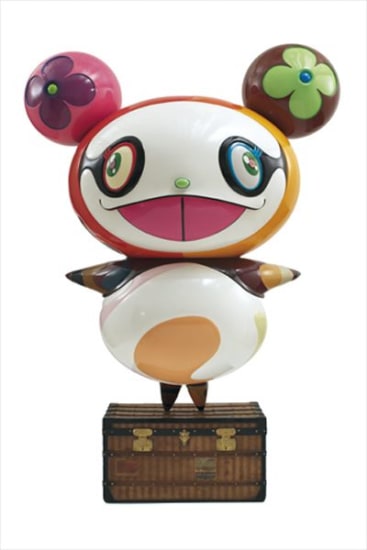21 Takashi Murakami Pom and Me 2010 gold leaf on aluminium, glass, chromed metal, with steel armature and Corian plinth 128.5 x 107.1 x 90.1 cm (50 5/8 x 42 1/8 x 35 1/2 in.)
Provenance Galerie Emmanuel Perrotin, Paris Exhibited Doha, Al Riwaq Exhibition Hall, Takashi Murakami Ego at Al Riwaq Exhibition Hall, 9 February - 23 June 2012 (other example exhibited) Catalogue Essay Takashi Murakami has transformed Japanese art for the twenty-first century. In a postmodern and global impulse, he coined an aesthetic he calls Superflat: ‘Murakami's attempt to reanimate a pre-Westernized, putatively indigenous, Japanese artistic perspective in forms that simultaneously accommodate a thoroughly Westernized popular culture.’ (Nina Cornyetz, ‘Murakami Takashi and the Hell of Others: Sexual (In)Difference, the Eye, and the Gaze in ©Murakami,' Criticism, Vol.54 No.2, Spring 2012, p.182). This involves a wryly recombinant eye, taking cues from the distinctive flat planes of anime and manga and, in a concept in accordance with his visuals, ‘flattening’ the boundaries between low and high culture. He reconstitutes his art as merchandise – the gift shop at a 2009 Tate Modern exhibition sold miniature versions of key works packaged with chewing gum – and also incorporates imagery from his commercial work back into paintings and sculptures. The huge success of his designs with Marc Jacobs for Louis Vuitton and his album art for Kanye West’s Graduation have elevated him to celebrity status, cementing his position in popular culture, yet he remains a puckish and somewhat enigmatic figure; he is no diffident ambassador for Japan, but a razor-sharp alchemist of art and commerce. It is tempting to draw comparisons to Warhol. There are clear parallels in the artists’ narratives of serialisation and their blurring of lines between ‘high art’ and mass-produced imagery; Murakami even employs a team of assistants in Kaikai Kiki, a ‘factory’ rather like Warhol’s. Yet to trace a clear lineage here is to ignore the distinctive Japanese quality of Murakami’s project. As Massimiliano Gioni writes, ‘If Warhol’s factory was a perverse, hypertrophic emulation of assembly-line systems, Kaikai Kiki is a demented replica of a multinational corporation.’ (Massimiliano Gioni, ‘Takashi Murakami: Ego Mix,' Murakami - Ego, New York: Skira Rizzoli, 2012, p.117). The atelier structure of Murakami’s production has as much in common with the anime workshops of Studio Ghibli as it does with the Factory. And as Murakami himself notes, ‘I’m very sad to be compared with Warhol and the Factory, because I have no drugs, you know. We have no drug culture in Japan! Maybe it’s because our attitude toward labour is totally different.’ (Takashi Murakami in conversation with Alison Gingeras, Interview Magazine, 8 September 2010). Incorporating a wide range of operations, Kaikai Kiki does much work to support emerging young Japanese artists, and since 2002 has managed GEISAI, an art fair in which artists interact directly with potential buyers. In Japan, Murakami claims, people ‘are surprised by the rigid and pretentious Western hierarchy of “high art.” In the West, it certainly is dangerous to blend the two because people will throw all sorts of stones. But that’s okay – I’m ready with my hard hat.’ (Takashi Murakami in conversation with Magdalene Perez, ARTINFO, 17 May 2007). Pom and Me is a shining example of Murakami’s sculpture. From a line created in gold, silver, bronze and painted fibreglass, the sculpture recalls the chromed quality of Jeff Koons’ balloon dogs, but presents an altogether more lively pair of figures; Murakami himself stands in declamatory pose alongside his canine companion. The artist’s dog – with whom he shares the popular Instagram feed @takashipom – is, appropriately, of rare indigenous Japanese breed. He acquired her with three other puppies from a hotel in Yoronjima, and when he took her home the vet hold him ‘that almost 90 percent of dogs in Japan come from the West. So she is like an original. The vet was excited and was asking about where she came from. He wanted to meet the breeder.’ (Takashi Murakami in conversation with Al
21 Takashi Murakami Pom and Me 2010 gold leaf on aluminium, glass, chromed metal, with steel armature and Corian plinth 128.5 x 107.1 x 90.1 cm (50 5/8 x 42 1/8 x 35 1/2 in.)
Provenance Galerie Emmanuel Perrotin, Paris Exhibited Doha, Al Riwaq Exhibition Hall, Takashi Murakami Ego at Al Riwaq Exhibition Hall, 9 February - 23 June 2012 (other example exhibited) Catalogue Essay Takashi Murakami has transformed Japanese art for the twenty-first century. In a postmodern and global impulse, he coined an aesthetic he calls Superflat: ‘Murakami's attempt to reanimate a pre-Westernized, putatively indigenous, Japanese artistic perspective in forms that simultaneously accommodate a thoroughly Westernized popular culture.’ (Nina Cornyetz, ‘Murakami Takashi and the Hell of Others: Sexual (In)Difference, the Eye, and the Gaze in ©Murakami,' Criticism, Vol.54 No.2, Spring 2012, p.182). This involves a wryly recombinant eye, taking cues from the distinctive flat planes of anime and manga and, in a concept in accordance with his visuals, ‘flattening’ the boundaries between low and high culture. He reconstitutes his art as merchandise – the gift shop at a 2009 Tate Modern exhibition sold miniature versions of key works packaged with chewing gum – and also incorporates imagery from his commercial work back into paintings and sculptures. The huge success of his designs with Marc Jacobs for Louis Vuitton and his album art for Kanye West’s Graduation have elevated him to celebrity status, cementing his position in popular culture, yet he remains a puckish and somewhat enigmatic figure; he is no diffident ambassador for Japan, but a razor-sharp alchemist of art and commerce. It is tempting to draw comparisons to Warhol. There are clear parallels in the artists’ narratives of serialisation and their blurring of lines between ‘high art’ and mass-produced imagery; Murakami even employs a team of assistants in Kaikai Kiki, a ‘factory’ rather like Warhol’s. Yet to trace a clear lineage here is to ignore the distinctive Japanese quality of Murakami’s project. As Massimiliano Gioni writes, ‘If Warhol’s factory was a perverse, hypertrophic emulation of assembly-line systems, Kaikai Kiki is a demented replica of a multinational corporation.’ (Massimiliano Gioni, ‘Takashi Murakami: Ego Mix,' Murakami - Ego, New York: Skira Rizzoli, 2012, p.117). The atelier structure of Murakami’s production has as much in common with the anime workshops of Studio Ghibli as it does with the Factory. And as Murakami himself notes, ‘I’m very sad to be compared with Warhol and the Factory, because I have no drugs, you know. We have no drug culture in Japan! Maybe it’s because our attitude toward labour is totally different.’ (Takashi Murakami in conversation with Alison Gingeras, Interview Magazine, 8 September 2010). Incorporating a wide range of operations, Kaikai Kiki does much work to support emerging young Japanese artists, and since 2002 has managed GEISAI, an art fair in which artists interact directly with potential buyers. In Japan, Murakami claims, people ‘are surprised by the rigid and pretentious Western hierarchy of “high art.” In the West, it certainly is dangerous to blend the two because people will throw all sorts of stones. But that’s okay – I’m ready with my hard hat.’ (Takashi Murakami in conversation with Magdalene Perez, ARTINFO, 17 May 2007). Pom and Me is a shining example of Murakami’s sculpture. From a line created in gold, silver, bronze and painted fibreglass, the sculpture recalls the chromed quality of Jeff Koons’ balloon dogs, but presents an altogether more lively pair of figures; Murakami himself stands in declamatory pose alongside his canine companion. The artist’s dog – with whom he shares the popular Instagram feed @takashipom – is, appropriately, of rare indigenous Japanese breed. He acquired her with three other puppies from a hotel in Yoronjima, and when he took her home the vet hold him ‘that almost 90 percent of dogs in Japan come from the West. So she is like an original. The vet was excited and was asking about where she came from. He wanted to meet the breeder.’ (Takashi Murakami in conversation with Al











Try LotSearch and its premium features for 7 days - without any costs!
Be notified automatically about new items in upcoming auctions.
Create an alert